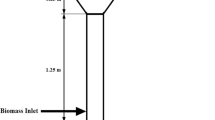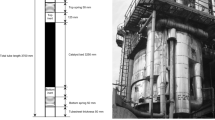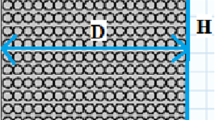Abstract
Heat and mass transfer processes and decomposition of organic compounds in a pyrolysis reactor are simulated using the ANSYS Fluent software package. Simulation of the pyrolysis of organic compounds, in contrast to simulation of their combustion, is dealt with only in a few studies. However, there are many engineering applications of this process, including thermal decomposition of various wastes where the use of pyrolysis, due to its specifics, seems to be very promising. Because of the wide variety of organic compounds, implementation of their processing in practice using the pyrolysis process depends heavily on the properties of a given feed and requires theoretical justification. A pyrolysis reactor equipped with a mixer is described, and the problem in the computer simulation of wetted polypropylene’s thermal decomposition is formulated. Polypropylene is a component of many medical products, such as catheters, transfusion systems, disposable syringes, etc. It has the highest decomposition heat among all components of medical waste and controls the maximum time of their decomposition. A description is given of a two-phase mathematical model consisting of the well-known mass, momentum, and energy conservation equations, mass transfer equation, and equation of state. The results from calculation of the propylene pyrolysis and the dynamics of thermal decomposition of a solid phase in a reactor are presented. The time of moisture evaporation and pyrolysis of a specimen at 600°С was determined. The hydrodynamic and heat transfer characteristics of the process enabling the performance of a thermal processing package and the requirements for the design of a test facility are considered. The results on the rate and time of polypropylene decomposition offer prospects for predicting the throughput capacity and loading frequency for the investigated reactor.















Similar content being viewed by others
REFERENCES
SanPiN 2.1.7.2790-10. Sanitary and Epidemiological Requirements for the Treatment of Medical Waste (Federal Service for the Oversight of Consumer Protection and Welfare, 2010).
I. M. Bernadiner, Dioxins and Other Toxicants during High-Temperature Processing and Disposal of Waste (Mosk. Energ. Inst., Moscow, 2007) [in Russian].
Worldwide Health Organization Official Website. http://www.who.int/ru.
C. S. Evans and B. Dellinger, “Mechanisms of dioxin formation from the high-temperature pyrolysis of 2-chlorophenol,” Environ. Sci. Technol. 7, 2128–2134 (2005).
ANSYS Fluent Theory Guide. Release 18.2.0 (ANSYS, 2017).
R. W. J. Westerhout, J. Waanders, J. A. M. Kuipers, and W. P. M. van Swaaij, “Experimental determination of the yield of pyrolysis products of polyethene and polypropene. Influence of reaction conditions,” Ind. Eng. Chem. Res., No. 36, 1955–1964 (1997).
K. Sachin and R. K. Singh, “Pyrolysis kinetics of waste high-density polyethylene using thermogravimetric analysis,” Int. J. Chem. Tech. Res. 6, 131–137 (2014).
Scientific and Technical Basis for Thermal Utilization of Municipal Solid Waste. http://www.stromkomposit.ru/42.html. Accessed June 26 2018.
J. Cai, Y. Yang, W. Cai, and T. Bridgwater, “Drying kinetic analysis of municipal solid waste using modified page model and pattern search method,” Waste Biomass Valorization 8, 301–312 (2016).
Funding
This work was financially supported by the Ministry of Education and Science of the Russian Federation under the engineering project “Development and Investigation of a Pyrolysis-Based Environmentally-Friendly Process for Safe Decontamination of Hazardous Medical and Biological Wastes” (project no. RFMEFI57617X0101).
Author information
Authors and Affiliations
Corresponding authors
Additional information
Translated by T. Krasnoshchekova
Rights and permissions
About this article
Cite this article
Zroichikov, N.A., Fadeev, S.A., Kaverin, A.A. et al. Simulation of Heat and Mass Transfer in an Organic Compound Pyrolysis Reactor. Therm. Eng. 66, 702–713 (2019). https://doi.org/10.1134/S0040601519100082
Received:
Revised:
Accepted:
Published:
Issue Date:
DOI: https://doi.org/10.1134/S0040601519100082




